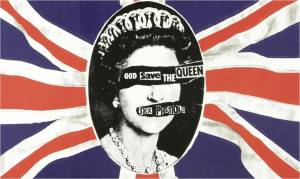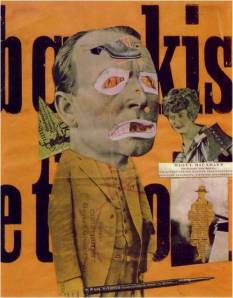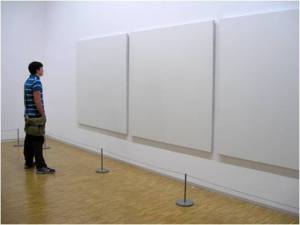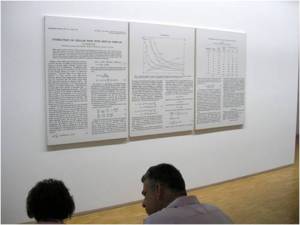You are currently browsing the tag archive for the ‘jamie reid’ tag.
I recently finished a project about Modernism which reminded me of an essay i’d written recently before i came to university. I used my own essay to find information about my presentation and used pictures from it.
Here it is:
Dada is Punk
Punk was born in 1974, Roughly 60 years after Dada, punk rock spread through the nation Mimicking dada’s “nothing is true; everything is permitted” Griel Marcus [1]attitude and so entered the world hating and questioning everything.
The message behind Dada and Punk are also surprisingly similar, Dada has been branded ‘The Anti – War movement’ Louis Aragon and Punk was a rebellion about anarchy and control. A big reason why these two movements are so similar is due to the fact that both movements were created out of social outburst. Dada was a fight against stereotypical ‘art’ and traditional beliefs, it wanted to make a statement about the fact that they believed that art could be anything and everything.
‘The movement was, among other things, a protest against the barbarism of the War and what Dadaists believed was an oppressive intellectual rigidity in both art and everyday society’
This is shown through Marcel Duchamp’s work which explores the theme of ‘What is art?’. This was also accompanied by the fact that Dada was during the war and so Dadaist artists had little money and, as a result, little resources. Because of this they began finding art in the things around them; this is how the cut and paste aesthetic that is demonstrated through both Dada, and then later, Punk was born. Punk was a fight against the government, it was about Anarchy and rebellion, punk fought back against the norm and created a movement about freedom.
An example of this social outburst in punk would be that an actor, named Christian Bale in court once asked the jury ‘have you ever had a bad day and ever lost your temper and really regretted it immensely?’ Bale says that in his outburst of anger he ‘Acted like a punk’. This statement shows that punk, in the eye of the public, is associated directly to outburst.
Society are only willing to live in a world which they dislike for a certain amount of time, and when that time is up, rebellion strikes whether it is through physical violence and attack or through expression in art and music.
Dadaism wasn’t about clean cut Images and sophisticated masterpieces; it was about cut and paste, using the resources available to you.
This expression is something which both Dadaist and Punk artists share; they used anything they could find for inspiration. Dada used things such as rubbish, cardboard and newspapers to express themselves, a key example of this is shown through Marcel Duchamp. Duchamp is easily one of the most renowned Dadaist artists, his piece ‘The Fountain’; a signed urinal, raised numerous questions and had people ‘screaming the question of what is art?’ becKsEarleScoTt This not only stretched the boundaries of art but also stretched people’s perceptions of what art is and could be. The image is shown below:
‘Fountain’ 1917 a urinal by Marcel Duchamp signed ‘R. Mutt 1917’
As mentioned above, this theme of ‘what is art’ and using anything for inspiration was mirrored and recurred through punk. For example, many punk artists used
Dadaist artwork on their album covers; Jamie Reid’s ‘use of the safety pin through the queen’s face’ for The Sex Pistols was in fact ‘directly taken from the work of Marcel Duchamp’. becKsEarleScoTt and also Emit Snake- Beings says that ‘The work of Jamie Reid was clearly influenced by the image and type collages of the Dadaists and the Futurists.’ And also that ‘Jamie Reid gave the punk movement a look that stemmed from Dadaism’
According to Polly Cantlon ‘The work of Jamie Reid was clearly influenced by the image and type collages of the Dadaists. These influences on Reid’s typography, with its deliberately erratic and eclectic mixing of fonts, sizes and styles, can be seen in many Dadaist artworks.’ Also, the idea of using reachable resources is shown through Jamie Reid’s artwork made for The Sex Pistols, this artwork was made from things such as defaced images, ripped up flags and was detailed with things like safety pins.
Reid’s work relates strongly to the Dadaist artist Raoul Hausmann in that they both feature defaced images, a strong personal message and both feature the ‘powerful ransom note and newspaper clipping style that became so iconic’. Sleevage For example, Reid’s ‘anarchy in the UK’ ripped up the British flag and his ‘God Save the Queen’ defaced her highness’s portrait.
‘The Art Critic’ by Raoul Hausmann 1919-1920.
Hausmann’s ‘The art critic’ is made from crayon, ink stamp and photomontage and collage on a printed poster poem. Although no exact style can be associated with Dada, this work sums up the Dadaist technique in using what little materials they had. ‘The backing away from traditional painting techniques as a form of protest led to a lot of collage being used’ becKsEarleScoTt
Also, the strong personal meanings behind both pieces of work make them even more similar, Punk’s ‘anarchy’ is portrayed through Jamie Reid’s creations and Dada’s disgust with traditional critics is portrayed through Raoul Hausmann’s creations.
According to Dadaist Artist Hans Richtner, ‘”the confusion was only a cover”’. The punks, much like the Dadaists used the technique of shock to get their point across. Punks used unexpected language, as seen in the Bill Grundy interview, and Dadaists were more subtle. Their profanity was in Duchamp’s reworking of the Mona Lisa,
‘Mona Lisa’ by Marcel Duchamp 1919 or otherwise known as LHOOQ, which translates to “She’s Got A Hot Ass”.
Both Punk and Dada were inspired to get up and take a stand, they didn’t settle when there were no resources, they stood up and found their own resources to create art with. This show of motivation inspired the public of the time significantly.
“The original punk image was first and foremost one of individuality” [3] Johnny rotten, the sex pistols vocalist, was one of the first real punks of the time; he helped to create the image that punk was about. It wasn’t about looking different; their fashion purely came from the fact that “if the bottom fell out of his trousers and he couldn’t afford any more, the obvious thing to do was hold them together with safety pins” [4] and was about “making your own look” [5]. The inspiration of the public was soon branded as ‘jumping on the band wagon’ – people who “shared feelings of disillusionment, anger, and the sense of being unwanted outcasts” [6] at the time wanted to support the movements and join in, people started ripping up perfectly good clothes and putting safety pins in them. This act created the end of punk the expression and branded the beginning of punk the fashion.
However, because Punk the expression is over, this doesn’t mean that Dada has now ceased to exist. It would appear that Dada lives on through the different revelations of time, growing and developing as it moves forward. This idea is demonstrated through Modern Art. Just like Marcel Duchamp, Modern art questions what exactly art is:
This image literally shows three Canvas’s that have been painted completely white. The Artist insists that the colour white represents nothing. This theory is much like the Dadaist theory ‘Dada strives to have no meaning’.
However, with time moving forward, the movement is developing a new vision and idea, for example not only are the Modern Artists of today questioning ‘what is art?’ but they are also questioning ‘Is science art?’.
This image shows reprints a scientific paper in its entirety: “Interaction of stellar wind with diffuse nebulae,” by S.B. Pikel’ner.
In conclusion, it is clear that Dada was a turning point; it shook the meaning of art and has continued to question the foundations until today. However, it is also clear that this expression has moved through time twisting and changing slightly as it resides under the names of different movements. Given the evidence here, it is fair to say that Dada is Punk and that Dada and Punk are Modern Art, these are just slightly altered movements which have stemmed from their one of the same.
Written by Ashleigh Berryman









